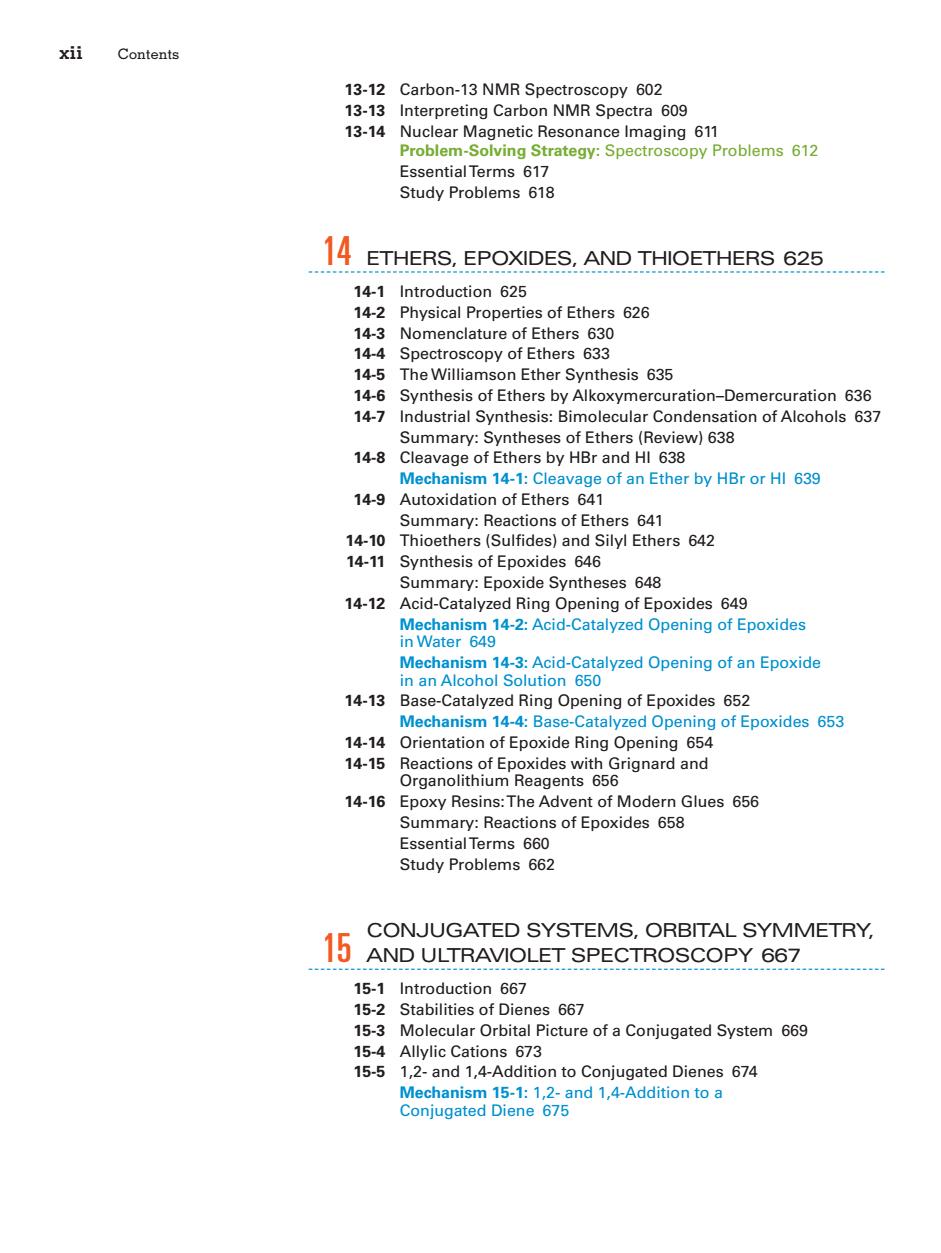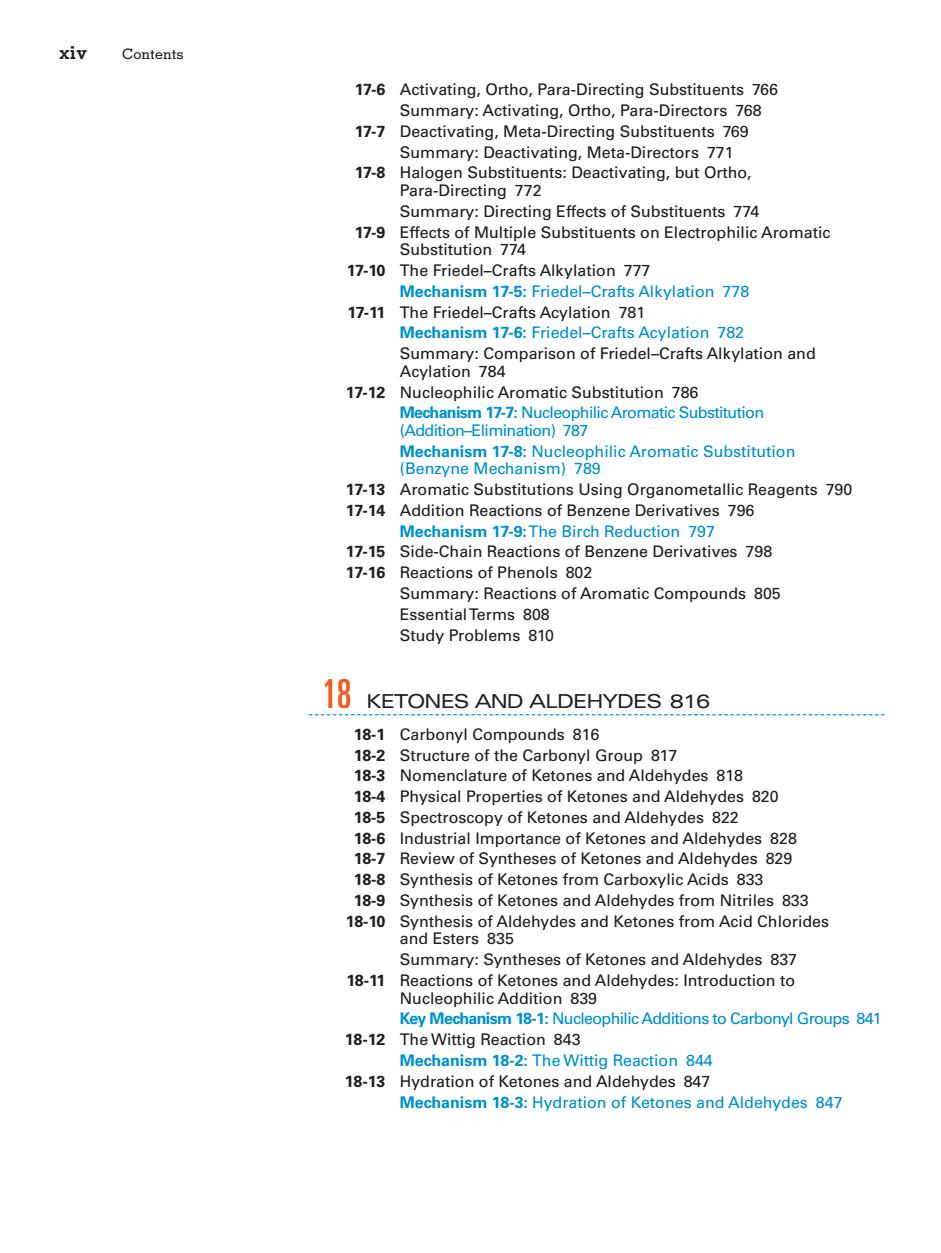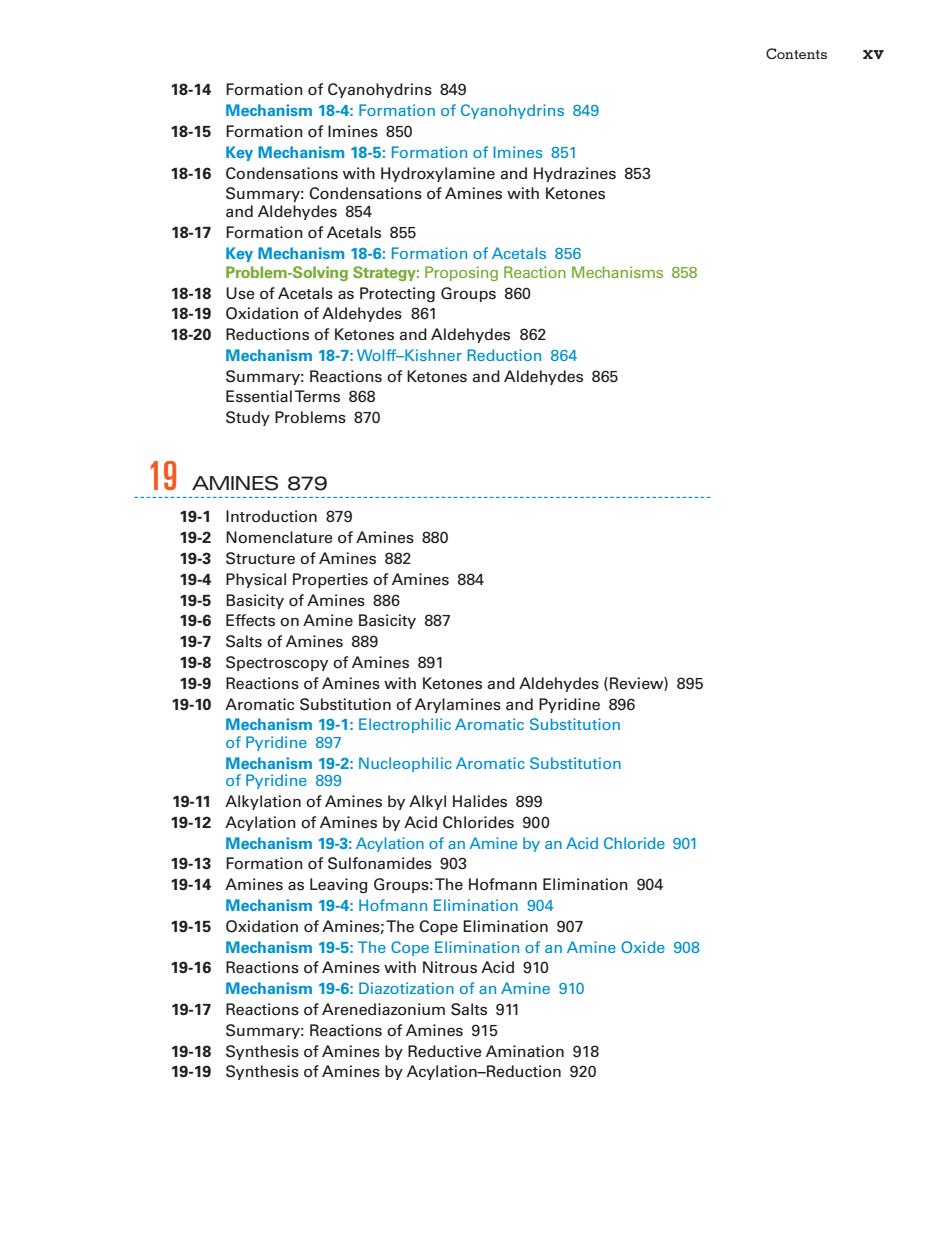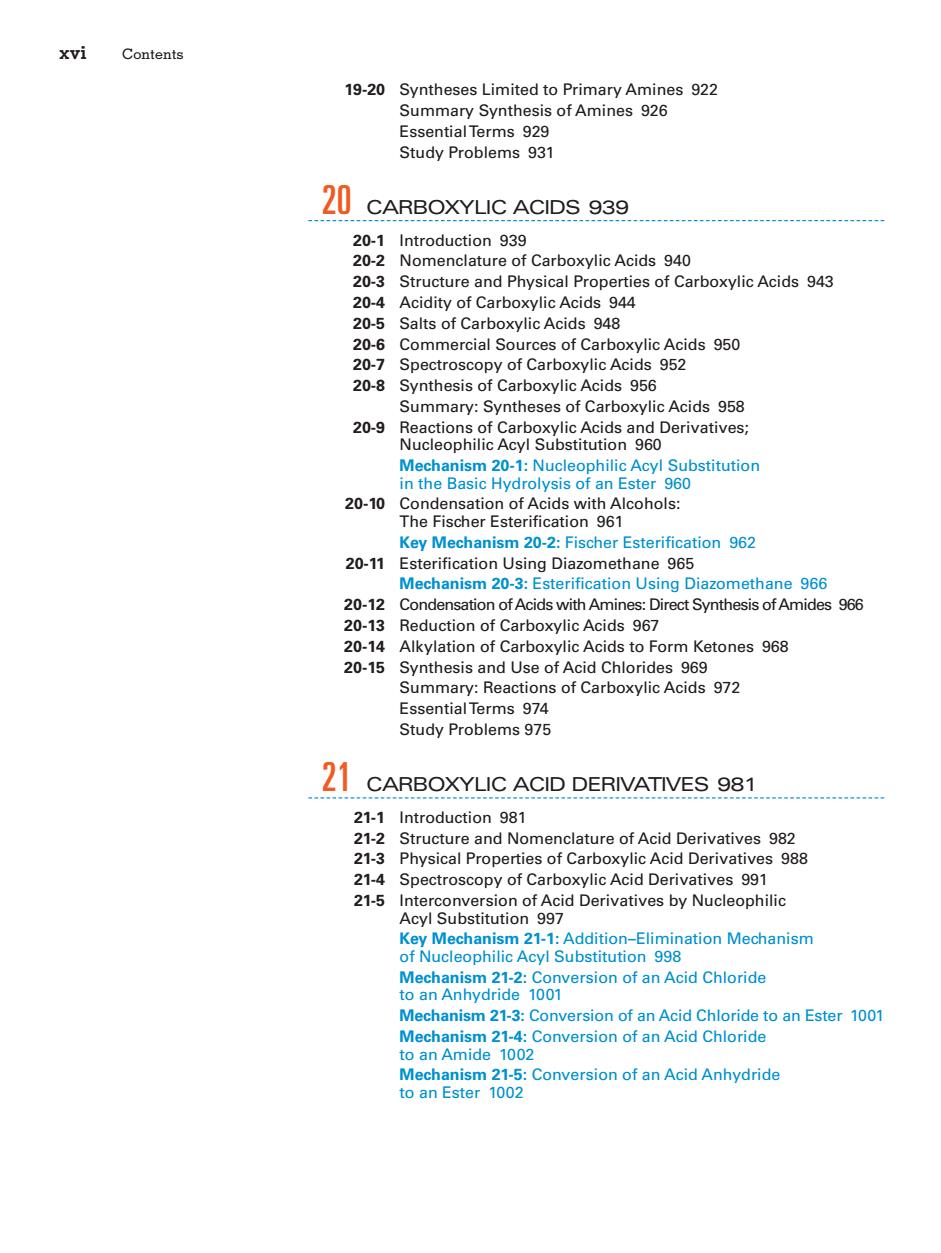
xii Contents 13-12 Carbon-13 NMR Spectroscopy 602 13-13 Interpreting Carbon NMR S ectra 609 13-14 Essential Terms 617 Study Problems 618 14 ETHERS,EPOXIDES,AND THIOETHERS 625 14-1 Introduction 625 14.2 Physical Properties of Ethers 626 14-3 Nomenclature of Ethers 630 14-4 Spectroscony of Ethers 633 14-5 The Williamson Ether Synthesis 635 14-6 Synthesis of Ethers by Alkoxymercuration-Demercuration 636 14-7 Industrial Synthesis:Bimolecular Condensation of Alcohols 637 Summary:Syntheses of Ethers(Review)638 14-8 Cleavage of Ethers by HBr and HI 638 Mechanism 14-1:Cleavage of an Ether by HBr or HI 639 14-9 Autoxidation of Ethers 641 Summary:Reac ons of Ethers 641 Thioethers(Sulfid Synthesis Epo 8g946S1Ehers642 ses 64 14-12 ed Ring g of poxides lyzed Opening of Epoxides Mechanism 14-3:Acid-Catalyzed Opening of an Epoxide in an Alcohol Solution 650 14-13 Base-Catalyzed Ring Opening of Epoxides 652 chanism 1 Base atalyzed Opening of Epoxides 653 Orientation of Epo: de Ring Opening 65 Grignard anc 14.16 xy Resins:The Advent of Modern Glues 656 Summary:Reactions of Epoxides 658 EssentialTerms 660 Study Problems 662 15 CONJUGATED SYSTEMS,ORBITAL SYMMETRY, AND ULTRAVIOLET SPECTROSCOPY 667 15-1 Introduction 667 152 Stabilities of Dienes 667 1 Molecular Orbital Picture of a Conjugated System 669 Allylic C and 1. 67E nto Conj gated Dienes 674 Conjugated Diene nd 1. 675
xii Contents 13-12 Carbon-13 NMR Spectroscopy 602 13-13 Interpreting Carbon NMR Spectra 609 13-14 Nuclear Magnetic Resonance Imaging 611 Problem-Solving Strategy: Spectroscopy Problems 612 Essential Terms 617 Study Problems 618 14 ETHERS, EPOXIDES, AND THIOETHERS 625 14-1 Introduction 625 14-2 Physical Properties of Ethers 626 14-3 Nomenclature of Ethers 630 14-4 Spectroscopy of Ethers 633 14-5 The Williamson Ether Synthesis 635 14-6 Synthesis of Ethers by Alkoxymercuration–Demercuration 636 14-7 Industrial Synthesis: Bimolecular Condensation of Alcohols 637 Summary: Syntheses of Ethers (Review) 638 14-8 Cleavage of Ethers by HBr and HI 638 Mechanism 14-1: Cleavage of an Ether by HBr or HI 639 14-9 Autoxidation of Ethers 641 Summary: Reactions of Ethers 641 14-10 Thioethers (Sulfides) and Silyl Ethers 642 14-11 Synthesis of Epoxides 646 Summary: Epoxide Syntheses 648 14-12 Acid-Catalyzed Ring Opening of Epoxides 649 Mechanism 14-2: Acid-Catalyzed Opening of Epoxides in Water 649 Mechanism 14-3: Acid-Catalyzed Opening of an Epoxide in an Alcohol Solution 650 14-13 Base-Catalyzed Ring Opening of Epoxides 652 Mechanism 14-4: Base-Catalyzed Opening of Epoxides 653 14-14 Orientation of Epoxide Ring Opening 654 14-15 Reactions of Epoxides with Grignard and Organolithium Reagents 656 14-16 Epoxy Resins: The Advent of Modern Glues 656 Summary: Reactions of Epoxides 658 Essential Terms 660 Study Problems 662 15 CONJUGATED SYSTEMS, ORBITAL SYMMETRY, AND ULTRAVIOLET SPECTROSCOPY 667 15-1 Introduction 667 15-2 Stabilities of Dienes 667 15-3 Molecular Orbital Picture of a Conjugated System 669 15-4 Allylic Cations 673 15-5 1,2- and 1,4-Addition to Conjugated Dienes 674 Mechanism 15-1: 1,2- and 1,4-Addition to a Conjugated Diene 675

Contents xiii 15-6 15-7 Allylic Radicals 678 Mechanism 15-2:Free-Radical allylic Bromination 678 15-8 Molecular Orbitals of the Allylic System 680 15-9 Electronic Configurations of the Allyl Radical,Cation,and Anion 681 15-10 15-11 The Diels-Alder Reaction 684 Key Mechani sm 15-3:The Diels-Alder Reaction 684 15.12 The diels-Alder as an example of a pericyclic reaction 692 15-13 Ultraviolet Absorption Spectroscopy 696 15.14 Colored Organic Compounds 701 15-15 UV-Visible Analysis in Biology and Medicine 704 EssentialTerms 706 Study Problems 708 16 AROMATIC COMPOUNDS 713 16-1 Introduction:The Discovery of Benzene 713 16-2 The Structure and Properties of Benzene 713 16-3 The Molecular Orbitals of Benzene 717 16-4 The Molecular Orbital Picture of Cyclobutadiene 720 16-5 Aromatic,Antiaromatic,and Nonaromatic Compounds 722 16-6 Huckel's Rule 722 16-7 Molecular Orbital Derivation of Huckel's Rule 725 16-8 Aromatic lons 726 16-9 Heterocyclic Aromatic Compounds 731 16-10 Polynuclear Aromatic Hydrocarbo s735 16-11 Aromatic Allotropes of Carbon 737 16-1 Fused Heterocyclic Compounds 739 16-13 Nom nclature ot Benz ne Derivatives 740 1818 Physical Prope s of Be zene and Its De tial topy of A Stu d 17 REACTIONS OF AROMATIC COMPOUNDS 756 17-1 Electrophilic Aromatic Substitution 756 Key Mechanism 17-1:Electrophilic Aromatic Substitution 757 17-2 Halogenation of Benzene 758 Mechanism 17-2:Bromination of Benzene 758 17-3 anism 173: ene 760 Nitrati of Benzene 760 17-4 Sulf nzene 76 anism 4: n of B 764 17-5 Nitration of luene:The Ef ubstitution 763
Contents xiii 15-6 Kinetic versus Thermodynamic Control in the Addition of HBr to Buta-1,3-diene 676 15-7 Allylic Radicals 678 Mechanism 15-2: Free-Radical Allylic Bromination 678 15-8 Molecular Orbitals of the Allylic System 680 15-9 Electronic Configurations of the Allyl Radical, Cation, and Anion 681 15-10 SN2 Displacement Reactions of Allylic Halides and Tosylates 683 15-11 The Diels–Alder Reaction 684 Key Mechanism 15-3:The Diels–Alder Reaction 684 15-12 The Diels–Alder as an Example of a Pericyclic Reaction 692 15-13 Ultraviolet Absorption Spectroscopy 696 15-14 Colored Organic Compounds 701 15-15 UV-Visible Analysis in Biology and Medicine 704 Essential Terms 706 Study Problems 708 16 AROMATIC COMPOUNDS 713 16-1 Introduction: The Discovery of Benzene 713 16-2 The Structure and Properties of Benzene 713 16-3 The Molecular Orbitals of Benzene 717 16-4 The Molecular Orbital Picture of Cyclobutadiene 720 16-5 Aromatic, Antiaromatic, and Nonaromatic Compounds 722 16-6 Hückel’s Rule 722 16-7 Molecular Orbital Derivation of Hückel’s Rule 725 16-8 Aromatic Ions 726 16-9 Heterocyclic Aromatic Compounds 731 16-10 Polynuclear Aromatic Hydrocarbons 735 16-11 Aromatic Allotropes of Carbon 737 16-12 Fused Heterocyclic Compounds 739 16-13 Nomenclature of Benzene Derivatives 740 16-14 Physical Properties of Benzene and Its Derivatives 742 16-15 Spectroscopy of Aromatic Compounds 743 Essential Terms 746 Study Problems 748 17 REACTIONS OF AROMATIC COMPOUNDS 756 17-1 Electrophilic Aromatic Substitution 756 Key Mechanism 17-1: Electrophilic Aromatic Substitution 757 17-2 Halogenation of Benzene 758 Mechanism 17-2: Bromination of Benzene 758 17-3 Nitration of Benzene 760 Mechanism 17-3: Nitration of Benzene 760 17-4 Sulfonation of Benzene 761 Mechanism 17-4: Sulfonation of Benzene 762 17-5 Nitration of Toluene: The Effect of Alkyl Substitution 763

xiv Contents 17-6 Activating.Ortho.Para-Directing Substituents 766 Summary:Activating.Ortho.Para-Directors 768 17-7 Deactivating.Meta-Directing Substituents 769 Summary:Deactivating,Meta-Directors 771 17-8 Halo en Substituents:Deactivating,but Ortho, Para-Directing 772 Summary:Directing Effects of Substituents 774 17-9 oMu Substituentson Electrophilic Aromatic 17.10 The Friedel-Crafts Alkylation 777 Mechanism 17-5:Friedel-Crafts Alkylation 778 17.11 The Friedel-Crafts Acylation 781 Mechanism 17-6 Friedel-Crafts Acvlation 782 -Akyaion and 17-12 Nucleophilic Aromatic Substitution 786 Mechanism 17-8:Nucle 17-13 Aromatic Substitutions Using Organometallic Reagents 790 17-14 Addition Reactions of Benzene Derivatives 796 Mechanism 17-9:The Birch Reduction 797 17.15 Side-Chain Reactions of Benzene Derivatives 798 17-16 Reactions of Phenols 802 Summary:Reactions of Aromatic Compounds 805 Essentia Study Problems 810 18 KETONES AND ALDEHYDES 816 18-1 Carbonyl Compounds 816 18-2 Structure of the Carbonyl Group 817 18-3 Nomen clature of Ketones and Aldehydes 818 Physical Properties of Ketones and Aldehydes 820 Spectroscopy of Ketones and Aldehydes 822 eny 828 0 tones trom Carbo: and nydes 833 18-10 and Esters 835 Summary:Syntheses of Ketones and Aldehydes 837 18-11 Reactions of Ketones and Aldehydes:Introduction to 1on839 ey leophilic Additions to Carbonyl Groups 841 18-12 1on843 2:The Wittig Reaction 18-13 Hydration ones and Al ebydes847 tones and Aldehydes 847
17-6 Activating, Ortho, Para-Directing Substituents 766 Summary: Activating, Ortho, Para-Directors 768 17-7 Deactivating, Meta-Directing Substituents 769 Summary: Deactivating, Meta-Directors 771 17-8 Halogen Substituents: Deactivating, but Ortho, Para-Directing 772 Summary: Directing Effects of Substituents 774 17-9 Effects of Multiple Substituents on Electrophilic Aromatic Substitution 774 17-10 The Friedel–Crafts Alkylation 777 Mechanism 17-5: Friedel–Crafts Alkylation 778 17-11 The Friedel–Crafts Acylation 781 Mechanism 17-6: Friedel–Crafts Acylation 782 Summary: Comparison of Friedel–Crafts Alkylation and Acylation 784 17-12 Nucleophilic Aromatic Substitution 786 Mechanism 17-7: Nucleophilic Aromatic Substitution (Addition–Elimination) 787 Mechanism 17-8: Nucleophilic Aromatic Substitution (Benzyne Mechanism) 789 17-13 Aromatic Substitutions Using Organometallic Reagents 790 17-14 Addition Reactions of Benzene Derivatives 796 Mechanism 17-9:The Birch Reduction 797 17-15 Side-Chain Reactions of Benzene Derivatives 798 17-16 Reactions of Phenols 802 Summary: Reactions of Aromatic Compounds 805 Essential Terms 808 Study Problems 810 18 KETONES AND ALDEHYDES 816 18-1 Carbonyl Compounds 816 18-2 Structure of the Carbonyl Group 817 18-3 Nomenclature of Ketones and Aldehydes 818 18-4 Physical Properties of Ketones and Aldehydes 820 18-5 Spectroscopy of Ketones and Aldehydes 822 18-6 Industrial Importance of Ketones and Aldehydes 828 18-7 Review of Syntheses of Ketones and Aldehydes 829 18-8 Synthesis of Ketones from Carboxylic Acids 833 18-9 Synthesis of Ketones and Aldehydes from Nitriles 833 18-10 Synthesis of Aldehydes and Ketones from Acid Chlorides and Esters 835 Summary: Syntheses of Ketones and Aldehydes 837 18-11 Reactions of Ketones and Aldehydes: Introduction to Nucleophilic Addition 839 Key Mechanism 18-1: Nucleophilic Additions to Carbonyl Groups 841 18-12 The Wittig Reaction 843 Mechanism 18-2: The Wittig Reaction 844 18-13 Hydration of Ketones and Aldehydes 847 Mechanism 18-3: Hydration of Ketones and Aldehydes 847 xiv Contents

Contents 18-14 Mermatio sm on of Cyanohydrins 849 18-15 0850 85 ormation of Imines85 18-16 mine 853 and Aldehydes 854 18-17 Formation of Acetals 855 Key Mechanism 18-6:Formation of Acetals 856 roblem-Solving Strategy:Proposing Re action Mechanisms 858 18-18 ng Groups 860 1828 ehydes 86 echanis 862 shner Red 86os of Ketones and A h86 lehydes 865 Study proble ms870 19 AMINES 879 19- Introduction 879 - e of Ami 880 19 Str ture e of A ys Amines 884 ty c 19.2 Effec m 896 city 887 Salts of Ar 19-8 19.9 actio p of Amines 891 19-10 ones and Aldehydes(Review)895 atic Substitut of Ar Mechanism 19-1:Electrophilic Ard atic S of Pyridine 897 nism-2:Nucleophilic Aromatic Substitution 19-11 A 19.12 es by Alkyl Halides Acid Chlo 900 19.2.A e by an Acid Chloride 901 19.12 19-14 Amines as Leaving Gro os:The Hofmann elimination 904 Mechanism 19-4:Hofmann Elimination 904 19-15 Oxidation of Amines:The cope Elimination 907 Mechanism 19-5:The Cope Elimination of an Amine Oxide 908 19-16 Reactions of amines with nitrous acid 910 Mechanism 19-6:Diazotization of an Amine 910 19-17 Reactions of Arenediazonium Salts 911 Summary:Reactions of Amines 915 19-18 Synthesis of Amines by Reductive Amination 918 19-19 Synthesis of Amines by Acylation-Reduction 920
Contents xv 18-14 Formation of Cyanohydrins 849 Mechanism 18-4: Formation of Cyanohydrins 849 18-15 Formation of Imines 850 Key Mechanism 18-5: Formation of Imines 851 18-16 Condensations with Hydroxylamine and Hydrazines 853 Summary: Condensations of Amines with Ketones and Aldehydes 854 18-17 Formation of Acetals 855 Key Mechanism 18-6: Formation of Acetals 856 Problem-Solving Strategy: Proposing Reaction Mechanisms 858 18-18 Use of Acetals as Protecting Groups 860 18-19 Oxidation of Aldehydes 861 18-20 Reductions of Ketones and Aldehydes 862 Mechanism 18-7: Wolff–Kishner Reduction 864 Summary: Reactions of Ketones and Aldehydes 865 Essential Terms 868 Study Problems 870 19 AMINES 879 19-1 Introduction 879 19-2 Nomenclature of Amines 880 19-3 Structure of Amines 882 19-4 Physical Properties of Amines 884 19-5 Basicity of Amines 886 19-6 Effects on Amine Basicity 887 19-7 Salts of Amines 889 19-8 Spectroscopy of Amines 891 19-9 Reactions of Amines with Ketones and Aldehydes (Review) 895 19-10 Aromatic Substitution of Arylamines and Pyridine 896 Mechanism 19-1: Electrophilic Aromatic Substitution of Pyridine 897 Mechanism 19-2: Nucleophilic Aromatic Substitution of Pyridine 899 19-11 Alkylation of Amines by Alkyl Halides 899 19-12 Acylation of Amines by Acid Chlorides 900 Mechanism 19-3: Acylation of an Amine by an Acid Chloride 901 19-13 Formation of Sulfonamides 903 19-14 Amines as Leaving Groups: The Hofmann Elimination 904 Mechanism 19-4: Hofmann Elimination 904 19-15 Oxidation of Amines; The Cope Elimination 907 Mechanism 19-5: The Cope Elimination of an Amine Oxide 908 19-16 Reactions of Amines with Nitrous Acid 910 Mechanism 19-6: Diazotization of an Amine 910 19-17 Reactions of Arenediazonium Salts 911 Summary: Reactions of Amines 915 19-18 Synthesis of Amines by Reductive Amination 918 19-19 Synthesis of Amines by Acylation–Reduction 920

xvi Contents 19-20 Syntheses limited to Primary Amines 922 nmaYmgofAmmesa6 ntial Ter ms 929 Study Problems 93】 20 CARBOXYLIC ACIDS 939 of Carb 20-3 re perties of carboxylic acids 943 20-4 Acidity of Carbo ylic Acids 944 20-5 Salts of Carboxylic Acids 948 20-6 Commercial Sources of Carboxylic Acids 950 20.7 Spectroscony of carboxylic Acids 952 20-8 Svnthesis of Carboxvlic Acids 956 Summary:Svntheses of Carboxvlic Acids 958 20-9 ABactionhilic ey SuBstruran s bstitution 20-10 Condensation of Acids with Alcohols: The Fis cher Esterification 961 Key Mechanism 20-2:Fischer Esterification 962 20-11 Esterification Using Diazomethane 965 nwsD新t3 Mec Conde sation ,966 uction c rboxylic Acids Form etones 968 s and U boxylic Acids to se o mma Acids 972 erm Study F 97 21 CARBOXYLIC ACID DERIVATIVES 981 21-1 Introduction 981 e and enclature of id De ivati ves 982 Prope tie es 98 Spectr opy of Acyl Substitution 997 cid Derivatives Key Mechanism 21-1:Addition-Elimination Mechanism of Nucleophilic Acyl Substitution 998 m 21-3:Conversion of an Acid Chloride to an Ester 1001 eahAnsm26sconversonofanAedcnionde
xvi Contents 19-20 Syntheses Limited to Primary Amines 922 Summary Synthesis of Amines 926 Essential Terms 929 Study Problems 931 20 CARBOXYLIC ACIDS 939 20-1 Introduction 939 20-2 Nomenclature of Carboxylic Acids 940 20-3 Structure and Physical Properties of Carboxylic Acids 943 20-4 Acidity of Carboxylic Acids 944 20-5 Salts of Carboxylic Acids 948 20-6 Commercial Sources of Carboxylic Acids 950 20-7 Spectroscopy of Carboxylic Acids 952 20-8 Synthesis of Carboxylic Acids 956 Summary: Syntheses of Carboxylic Acids 958 20-9 Reactions of Carboxylic Acids and Derivatives; Nucleophilic Acyl Substitution 960 Mechanism 20-1: Nucleophilic Acyl Substitution in the Basic Hydrolysis of an Ester 960 20-10 Condensation of Acids with Alcohols: The Fischer Esterification 961 Key Mechanism 20-2: Fischer Esterification 962 20-11 Esterification Using Diazomethane 965 Mechanism 20-3: Esterification Using Diazomethane 966 20-12 Condensation of Acids with Amines: Direct Synthesis of Amides 966 20-13 Reduction of Carboxylic Acids 967 20-14 Alkylation of Carboxylic Acids to Form Ketones 968 20-15 Synthesis and Use of Acid Chlorides 969 Summary: Reactions of Carboxylic Acids 972 Essential Terms 974 Study Problems 975 21 CARBOXYLIC ACID DERIVATIVES 981 21-1 Introduction 981 21-2 Structure and Nomenclature of Acid Derivatives 982 21-3 Physical Properties of Carboxylic Acid Derivatives 988 21-4 Spectroscopy of Carboxylic Acid Derivatives 991 21-5 Interconversion of Acid Derivatives by Nucleophilic Acyl Substitution 997 Key Mechanism 21-1: Addition–Elimination Mechanism of Nucleophilic Acyl Substitution 998 Mechanism 21-2: Conversion of an Acid Chloride to an Anhydride 1001 Mechanism 21-3: Conversion of an Acid Chloride to an Ester 1001 Mechanism 21-4: Conversion of an Acid Chloride to an Amide 1002 Mechanism 21-5: Conversion of an Acid Anhydride to an Ester 1002